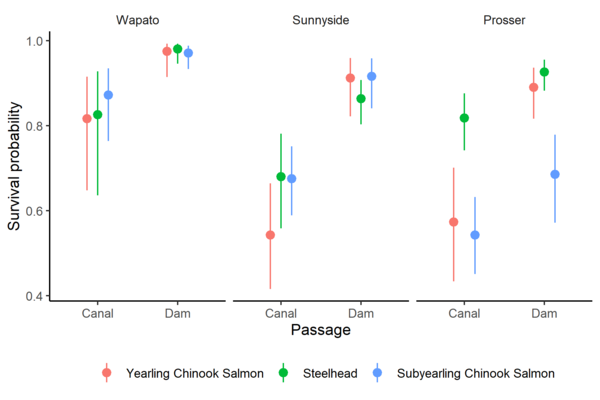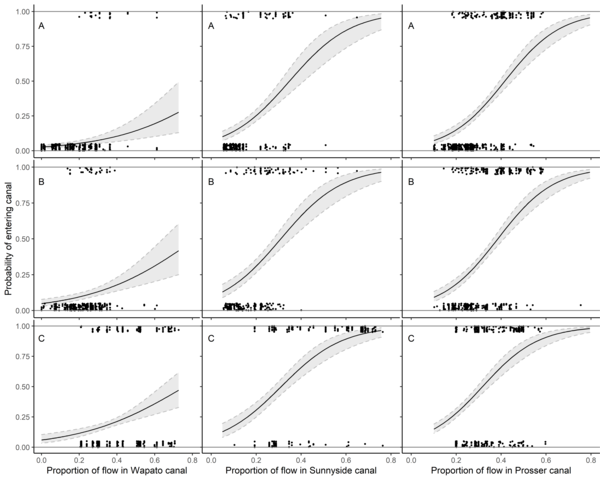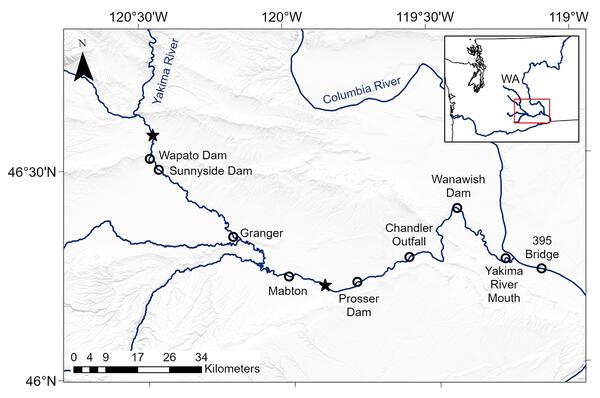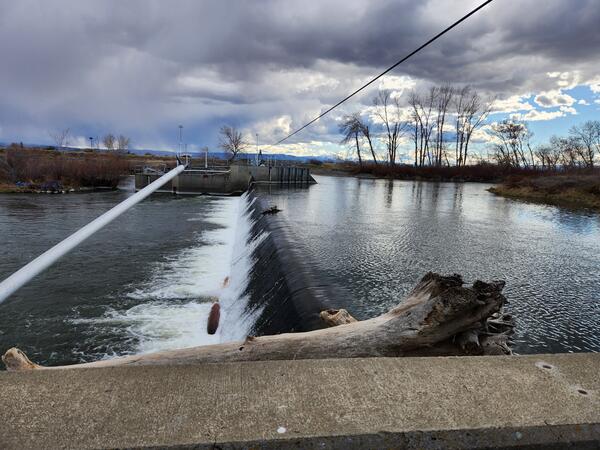This is a map of the lower Yakima River showing locations where acoustic telemetry receivers were deployed (open circles) to detect tagged fish that were released at two sites (stars). This was part of the study titled, "Survival implications of diversion entrainment for out-migrating juvenile Chinook Salmon and steelhead.
Tobias J Kock
Toby is a Supervisory Research Fish Biologist in the Western Fisheries Research Center who works out of the Columbia River Research Laboratory in Cook, Washington. His research is focused on Pacific salmon, dam passage and survival, ecology, and fish reintroductions throughout the western United States. His research is highly collaborative and includes State, Federal, Tribal and Private partners.
Toby’s research team conducts investigations focused on dam passage and survival for juvenile and adult Pacific salmon, assesses fish collection and passage devices, researches the ecological effects of high-head dams and reservoirs on anadromous fish, and evaluates various aspects of salmon and steelhead reintroductions upstream of impassable dams. He is currently working on studies that evaluate the effects of flow management on juvenile salmon survival, the responses of adult salmon and steelhead to trap-and-haul, assessment of dam-passage survival of juvenile salmon, and developing methods to estimate survival of salmon fry in reservoirs. His research is highly collaborative. Toby works closely with Tribal, State, Federal, and Private partners to provide unbiased science for use by a diverse group of partners in several watersheds across the western United States.
Professional Experience
2016-Present – Supervisory Research Fish Biologist, U.S. Geological Survey, Western Fisheries Research Center, Columbia River Research Laboratory, Cook, WA
2002 to 2016 - Fish Biologist, U.S. Geological Survey, Western Fisheries Science Center, Columbia River Research Laboratory, Cook, WA
2000-2002 - Graduate Student, University of Idaho, Moscow, ID
1998-2000 - Biological Science Technician, University of Idaho and U.S. Geological Survey
Education and Certifications
M.S. 2004. Fisheries Science, University of Idaho, Moscow, ID
B.A. 2000. Biology, Minor in Religion, Pacific Lutheran University, Tacoma, WA
Affiliations and Memberships*
American Fisheries Society
AFS-BES/ASCE-EWRI Joint Committee on Fisheries Engineering and Science (Webinar Task Group Member)
Science and Products
Willamette FIP Effectiveness Monitoring Framework
Scientific Support of Salmon and Steelhead Reintroductions in Impounded River Basins of the Pacific Northwest
Steelhead and Spring Chinook Adult Spawning Migration Study in the Klickitat River (Washington)
Acoustic-tagged juvenile late-fall Chinook salmon (Oncorhynchus tshawutscha) detections in Shasta Reservoir, McCloud River, CA, 2017-2018, 2024-2025 Acoustic-tagged juvenile late-fall Chinook salmon (Oncorhynchus tshawutscha) detections in Shasta Reservoir, McCloud River, CA, 2017-2018, 2024-2025
Acoustic-tagged juvenile Chinook salmon (Oncorhynchus tshawytscha) detections in Lookout Point Reservoir and downstream in the Middle Fork Willamette River, Oregon, 2024-25 Acoustic-tagged juvenile Chinook salmon (Oncorhynchus tshawytscha) detections in Lookout Point Reservoir and downstream in the Middle Fork Willamette River, Oregon, 2024-25
Acoustic-tagged juvenile Chinook salmon (Oncorhynchus tshawytscha), steelhead (O. mykiss), and sockeye salmon (O. nerka) detections in the Yakima River, Washington, 2018-2024 (version 1.1, September 2025) Acoustic-tagged juvenile Chinook salmon (Oncorhynchus tshawytscha), steelhead (O. mykiss), and sockeye salmon (O. nerka) detections in the Yakima River, Washington, 2018-2024 (version 1.1, September 2025)
Acoustic-tagged juvenile Chinook salmon (Oncorhynchus tshawytscha) and juvenile Coho salmon (Oncorhynchus kisutch) detections in Tieton Reservoir, Yakima River, WA from 2024 Acoustic-tagged juvenile Chinook salmon (Oncorhynchus tshawytscha) and juvenile Coho salmon (Oncorhynchus kisutch) detections in Tieton Reservoir, Yakima River, WA from 2024
Acoustic-tagged juvenile Chinook salmon (Oncorhynchus tshawytscha) detections in Lookout Point Reservoir and downstream in the Middle Fork Willamette River, Oregon, 2023_24 Acoustic-tagged juvenile Chinook salmon (Oncorhynchus tshawytscha) detections in Lookout Point Reservoir and downstream in the Middle Fork Willamette River, Oregon, 2023_24
This is a map of the lower Yakima River showing locations where acoustic telemetry receivers were deployed (open circles) to detect tagged fish that were released at two sites (stars). This was part of the study titled, "Survival implications of diversion entrainment for out-migrating juvenile Chinook Salmon and steelhead.

Survival Probabilities of Fish Through Canals Versus Dams
Survival Probabilities of Fish Through Canals Versus DamsSurvival probability estimates and 95% confidence intervals for yearling Chinook Salmon, juvenile steelhead, and subyearling Chinook Salmon at three diversion dams on the Yakima River, Washington.
Survival Probabilities of Fish Through Canals Versus Dams
Survival Probabilities of Fish Through Canals Versus DamsSurvival probability estimates and 95% confidence intervals for yearling Chinook Salmon, juvenile steelhead, and subyearling Chinook Salmon at three diversion dams on the Yakima River, Washington.

Nine Panel Plot of Fish Passage Entrainment vs Canal Flow
Nine Panel Plot of Fish Passage Entrainment vs Canal FlowEstimated relationship between entrainment probability and proportion of river flow entering canals at Wapato Dam, Sunnyside Dam, and Prosser Dam on the Yakima River, Washington. The relationships are shown at the mean total river flow for (A) yearling Chinook Salmon, (B) juvenile steelhead, and (C) subyearling Chinook Salmon.
Nine Panel Plot of Fish Passage Entrainment vs Canal Flow
Nine Panel Plot of Fish Passage Entrainment vs Canal FlowEstimated relationship between entrainment probability and proportion of river flow entering canals at Wapato Dam, Sunnyside Dam, and Prosser Dam on the Yakima River, Washington. The relationships are shown at the mean total river flow for (A) yearling Chinook Salmon, (B) juvenile steelhead, and (C) subyearling Chinook Salmon.
This is a photo of a dam in the lower Yakima River. Efforts to ameliorate the negative effects of diversion dams on aquatic species of concern are important in rivers where water withdrawal supports agricultural economies, and they are likely to become increasingly important with impending climate change.
This is a photo of a dam in the lower Yakima River. Efforts to ameliorate the negative effects of diversion dams on aquatic species of concern are important in rivers where water withdrawal supports agricultural economies, and they are likely to become increasingly important with impending climate change.

Photograph of a fish release at the Keller Ferry Marina
Photograph of a fish release at the Keller Ferry MarinaPhotograph of a fish release at the Keller Ferry Marina, Lake Roosevelt, Lincoln County, Washington.
Photograph of a fish release at the Keller Ferry Marina
Photograph of a fish release at the Keller Ferry MarinaPhotograph of a fish release at the Keller Ferry Marina, Lake Roosevelt, Lincoln County, Washington.

Photograph of the Sanpoil River in northeast Washington State
Photograph of the Sanpoil River in northeast Washington StatePhotograph of the Sanpoil River in northeast Washington State. The Sanpoil River is upstream of Grand Coulee and is a tributary of the Columbia River.
Photograph of the Sanpoil River in northeast Washington State
Photograph of the Sanpoil River in northeast Washington StatePhotograph of the Sanpoil River in northeast Washington State. The Sanpoil River is upstream of Grand Coulee and is a tributary of the Columbia River.
USGS researchers from the Western Fisheries Research Center, Columbia River Research Laboratory and the Oregon Water Science Center recently completed a study that reviewed existing fisheries datasets and provided an overview of research approaches for estimating habitat availability and carrying capacity of Pacific salmon in the Willamette River Basin.
USGS researchers from the Western Fisheries Research Center, Columbia River Research Laboratory and the Oregon Water Science Center recently completed a study that reviewed existing fisheries datasets and provided an overview of research approaches for estimating habitat availability and carrying capacity of Pacific salmon in the Willamette River Basin.

Cle Elum River, a tributary of the Yakima River in Washington state
Cle Elum River, a tributary of the Yakima River in Washington stateThe Cle Elum River, a tributary of the Yakima River in Washington state. Sockeye salmon reintroduction efforts were initiated in the Cle Elum River by the Yakama Nation and Washington Department of Fish and Wildlife in 2009.
Cle Elum River, a tributary of the Yakima River in Washington state
Cle Elum River, a tributary of the Yakima River in Washington stateThe Cle Elum River, a tributary of the Yakima River in Washington state. Sockeye salmon reintroduction efforts were initiated in the Cle Elum River by the Yakama Nation and Washington Department of Fish and Wildlife in 2009.
Sunrise on Pompey Peak, Washington.
Outmigration behavior and survival of juvenile Chinook salmon (Oncorhynchus tshawytscha) in response to deep drawdown of the Lookout Point Project, Middle Fork Willamette River, Oregon Outmigration behavior and survival of juvenile Chinook salmon (Oncorhynchus tshawytscha) in response to deep drawdown of the Lookout Point Project, Middle Fork Willamette River, Oregon
Using parentage-based tagging to estimate survival of Chinook salmon fry in a large storage reservoir Using parentage-based tagging to estimate survival of Chinook salmon fry in a large storage reservoir
Expansion of smallmouth bass distribution and habitat overlap with juvenile Chinook salmon in the Willamette River, Oregon Expansion of smallmouth bass distribution and habitat overlap with juvenile Chinook salmon in the Willamette River, Oregon
Survival implications of diversion entrainment for outmigrating juvenile Chinook Salmon (Oncorhynchus tshawytscha) and steelhead (O. mykiss) Survival implications of diversion entrainment for outmigrating juvenile Chinook Salmon (Oncorhynchus tshawytscha) and steelhead (O. mykiss)
Science to support conservation action in a large river system: The Willamette River, Oregon, USA Science to support conservation action in a large river system: The Willamette River, Oregon, USA
Spatial and temporal overlap between hatchery- and natural-origin steelhead and Chinook salmon during spawning in the Klickitat River, Washington, USA Spatial and temporal overlap between hatchery- and natural-origin steelhead and Chinook salmon during spawning in the Klickitat River, Washington, USA
Behavior and movement of smallmouth bass (Micropterus dolomieu) near Bonneville Dam, Columbia River, Washington and Oregon, March–October 2022 Behavior and movement of smallmouth bass (Micropterus dolomieu) near Bonneville Dam, Columbia River, Washington and Oregon, March–October 2022
Assessment of habitat use by juvenile Chinook salmon (Oncorhynchus tshawytscha) in the Willamette River Basin, 2020–21 Assessment of habitat use by juvenile Chinook salmon (Oncorhynchus tshawytscha) in the Willamette River Basin, 2020–21
Assessing the efficacy of using a parentage-based tagging survival model to evaluate two sources of mortality for juvenile Chinook salmon (Oncorhynchus tshawytscha) in Lookout Point Reservoir, Oregon Assessing the efficacy of using a parentage-based tagging survival model to evaluate two sources of mortality for juvenile Chinook salmon (Oncorhynchus tshawytscha) in Lookout Point Reservoir, Oregon
Juvenile green sturgeon (Acipenser medirostris) movement during autumn and winter in the lower Sacramento River, California, 2016–20 Juvenile green sturgeon (Acipenser medirostris) movement during autumn and winter in the lower Sacramento River, California, 2016–20
Monitoring framework to evaluate effectiveness of aquatic and floodplain habitat restoration activities for native fish along the Willamette River, northwestern Oregon Monitoring framework to evaluate effectiveness of aquatic and floodplain habitat restoration activities for native fish along the Willamette River, northwestern Oregon
Assessment of habitat availability for juvenile Chinook salmon (Oncorhynchus tshawytscha) and steelhead (O. mykiss) in the Willamette River, Oregon Assessment of habitat availability for juvenile Chinook salmon (Oncorhynchus tshawytscha) and steelhead (O. mykiss) in the Willamette River, Oregon
Science and Products
Willamette FIP Effectiveness Monitoring Framework
Scientific Support of Salmon and Steelhead Reintroductions in Impounded River Basins of the Pacific Northwest
Steelhead and Spring Chinook Adult Spawning Migration Study in the Klickitat River (Washington)
Acoustic-tagged juvenile late-fall Chinook salmon (Oncorhynchus tshawutscha) detections in Shasta Reservoir, McCloud River, CA, 2017-2018, 2024-2025 Acoustic-tagged juvenile late-fall Chinook salmon (Oncorhynchus tshawutscha) detections in Shasta Reservoir, McCloud River, CA, 2017-2018, 2024-2025
Acoustic-tagged juvenile Chinook salmon (Oncorhynchus tshawytscha) detections in Lookout Point Reservoir and downstream in the Middle Fork Willamette River, Oregon, 2024-25 Acoustic-tagged juvenile Chinook salmon (Oncorhynchus tshawytscha) detections in Lookout Point Reservoir and downstream in the Middle Fork Willamette River, Oregon, 2024-25
Acoustic-tagged juvenile Chinook salmon (Oncorhynchus tshawytscha), steelhead (O. mykiss), and sockeye salmon (O. nerka) detections in the Yakima River, Washington, 2018-2024 (version 1.1, September 2025) Acoustic-tagged juvenile Chinook salmon (Oncorhynchus tshawytscha), steelhead (O. mykiss), and sockeye salmon (O. nerka) detections in the Yakima River, Washington, 2018-2024 (version 1.1, September 2025)
Acoustic-tagged juvenile Chinook salmon (Oncorhynchus tshawytscha) and juvenile Coho salmon (Oncorhynchus kisutch) detections in Tieton Reservoir, Yakima River, WA from 2024 Acoustic-tagged juvenile Chinook salmon (Oncorhynchus tshawytscha) and juvenile Coho salmon (Oncorhynchus kisutch) detections in Tieton Reservoir, Yakima River, WA from 2024
Acoustic-tagged juvenile Chinook salmon (Oncorhynchus tshawytscha) detections in Lookout Point Reservoir and downstream in the Middle Fork Willamette River, Oregon, 2023_24 Acoustic-tagged juvenile Chinook salmon (Oncorhynchus tshawytscha) detections in Lookout Point Reservoir and downstream in the Middle Fork Willamette River, Oregon, 2023_24
This is a map of the lower Yakima River showing locations where acoustic telemetry receivers were deployed (open circles) to detect tagged fish that were released at two sites (stars). This was part of the study titled, "Survival implications of diversion entrainment for out-migrating juvenile Chinook Salmon and steelhead.
This is a map of the lower Yakima River showing locations where acoustic telemetry receivers were deployed (open circles) to detect tagged fish that were released at two sites (stars). This was part of the study titled, "Survival implications of diversion entrainment for out-migrating juvenile Chinook Salmon and steelhead.

Survival Probabilities of Fish Through Canals Versus Dams
Survival Probabilities of Fish Through Canals Versus DamsSurvival probability estimates and 95% confidence intervals for yearling Chinook Salmon, juvenile steelhead, and subyearling Chinook Salmon at three diversion dams on the Yakima River, Washington.
Survival Probabilities of Fish Through Canals Versus Dams
Survival Probabilities of Fish Through Canals Versus DamsSurvival probability estimates and 95% confidence intervals for yearling Chinook Salmon, juvenile steelhead, and subyearling Chinook Salmon at three diversion dams on the Yakima River, Washington.

Nine Panel Plot of Fish Passage Entrainment vs Canal Flow
Nine Panel Plot of Fish Passage Entrainment vs Canal FlowEstimated relationship between entrainment probability and proportion of river flow entering canals at Wapato Dam, Sunnyside Dam, and Prosser Dam on the Yakima River, Washington. The relationships are shown at the mean total river flow for (A) yearling Chinook Salmon, (B) juvenile steelhead, and (C) subyearling Chinook Salmon.
Nine Panel Plot of Fish Passage Entrainment vs Canal Flow
Nine Panel Plot of Fish Passage Entrainment vs Canal FlowEstimated relationship between entrainment probability and proportion of river flow entering canals at Wapato Dam, Sunnyside Dam, and Prosser Dam on the Yakima River, Washington. The relationships are shown at the mean total river flow for (A) yearling Chinook Salmon, (B) juvenile steelhead, and (C) subyearling Chinook Salmon.
This is a photo of a dam in the lower Yakima River. Efforts to ameliorate the negative effects of diversion dams on aquatic species of concern are important in rivers where water withdrawal supports agricultural economies, and they are likely to become increasingly important with impending climate change.
This is a photo of a dam in the lower Yakima River. Efforts to ameliorate the negative effects of diversion dams on aquatic species of concern are important in rivers where water withdrawal supports agricultural economies, and they are likely to become increasingly important with impending climate change.

Photograph of a fish release at the Keller Ferry Marina
Photograph of a fish release at the Keller Ferry MarinaPhotograph of a fish release at the Keller Ferry Marina, Lake Roosevelt, Lincoln County, Washington.
Photograph of a fish release at the Keller Ferry Marina
Photograph of a fish release at the Keller Ferry MarinaPhotograph of a fish release at the Keller Ferry Marina, Lake Roosevelt, Lincoln County, Washington.

Photograph of the Sanpoil River in northeast Washington State
Photograph of the Sanpoil River in northeast Washington StatePhotograph of the Sanpoil River in northeast Washington State. The Sanpoil River is upstream of Grand Coulee and is a tributary of the Columbia River.
Photograph of the Sanpoil River in northeast Washington State
Photograph of the Sanpoil River in northeast Washington StatePhotograph of the Sanpoil River in northeast Washington State. The Sanpoil River is upstream of Grand Coulee and is a tributary of the Columbia River.
USGS researchers from the Western Fisheries Research Center, Columbia River Research Laboratory and the Oregon Water Science Center recently completed a study that reviewed existing fisheries datasets and provided an overview of research approaches for estimating habitat availability and carrying capacity of Pacific salmon in the Willamette River Basin.
USGS researchers from the Western Fisheries Research Center, Columbia River Research Laboratory and the Oregon Water Science Center recently completed a study that reviewed existing fisheries datasets and provided an overview of research approaches for estimating habitat availability and carrying capacity of Pacific salmon in the Willamette River Basin.

Cle Elum River, a tributary of the Yakima River in Washington state
Cle Elum River, a tributary of the Yakima River in Washington stateThe Cle Elum River, a tributary of the Yakima River in Washington state. Sockeye salmon reintroduction efforts were initiated in the Cle Elum River by the Yakama Nation and Washington Department of Fish and Wildlife in 2009.
Cle Elum River, a tributary of the Yakima River in Washington state
Cle Elum River, a tributary of the Yakima River in Washington stateThe Cle Elum River, a tributary of the Yakima River in Washington state. Sockeye salmon reintroduction efforts were initiated in the Cle Elum River by the Yakama Nation and Washington Department of Fish and Wildlife in 2009.
Sunrise on Pompey Peak, Washington.
Outmigration behavior and survival of juvenile Chinook salmon (Oncorhynchus tshawytscha) in response to deep drawdown of the Lookout Point Project, Middle Fork Willamette River, Oregon Outmigration behavior and survival of juvenile Chinook salmon (Oncorhynchus tshawytscha) in response to deep drawdown of the Lookout Point Project, Middle Fork Willamette River, Oregon
Using parentage-based tagging to estimate survival of Chinook salmon fry in a large storage reservoir Using parentage-based tagging to estimate survival of Chinook salmon fry in a large storage reservoir
Expansion of smallmouth bass distribution and habitat overlap with juvenile Chinook salmon in the Willamette River, Oregon Expansion of smallmouth bass distribution and habitat overlap with juvenile Chinook salmon in the Willamette River, Oregon
Survival implications of diversion entrainment for outmigrating juvenile Chinook Salmon (Oncorhynchus tshawytscha) and steelhead (O. mykiss) Survival implications of diversion entrainment for outmigrating juvenile Chinook Salmon (Oncorhynchus tshawytscha) and steelhead (O. mykiss)
Science to support conservation action in a large river system: The Willamette River, Oregon, USA Science to support conservation action in a large river system: The Willamette River, Oregon, USA
Spatial and temporal overlap between hatchery- and natural-origin steelhead and Chinook salmon during spawning in the Klickitat River, Washington, USA Spatial and temporal overlap between hatchery- and natural-origin steelhead and Chinook salmon during spawning in the Klickitat River, Washington, USA
Behavior and movement of smallmouth bass (Micropterus dolomieu) near Bonneville Dam, Columbia River, Washington and Oregon, March–October 2022 Behavior and movement of smallmouth bass (Micropterus dolomieu) near Bonneville Dam, Columbia River, Washington and Oregon, March–October 2022
Assessment of habitat use by juvenile Chinook salmon (Oncorhynchus tshawytscha) in the Willamette River Basin, 2020–21 Assessment of habitat use by juvenile Chinook salmon (Oncorhynchus tshawytscha) in the Willamette River Basin, 2020–21
Assessing the efficacy of using a parentage-based tagging survival model to evaluate two sources of mortality for juvenile Chinook salmon (Oncorhynchus tshawytscha) in Lookout Point Reservoir, Oregon Assessing the efficacy of using a parentage-based tagging survival model to evaluate two sources of mortality for juvenile Chinook salmon (Oncorhynchus tshawytscha) in Lookout Point Reservoir, Oregon
Juvenile green sturgeon (Acipenser medirostris) movement during autumn and winter in the lower Sacramento River, California, 2016–20 Juvenile green sturgeon (Acipenser medirostris) movement during autumn and winter in the lower Sacramento River, California, 2016–20
Monitoring framework to evaluate effectiveness of aquatic and floodplain habitat restoration activities for native fish along the Willamette River, northwestern Oregon Monitoring framework to evaluate effectiveness of aquatic and floodplain habitat restoration activities for native fish along the Willamette River, northwestern Oregon
Assessment of habitat availability for juvenile Chinook salmon (Oncorhynchus tshawytscha) and steelhead (O. mykiss) in the Willamette River, Oregon Assessment of habitat availability for juvenile Chinook salmon (Oncorhynchus tshawytscha) and steelhead (O. mykiss) in the Willamette River, Oregon
*Disclaimer: Listing outside positions with professional scientific organizations on this Staff Profile are for informational purposes only and do not constitute an endorsement of those professional scientific organizations or their activities by the USGS, Department of the Interior, or U.S. Government








